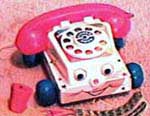

| Chatter Telephone | |
|---|---|
 Ring... Ring... Imagination calling |
The problem is children learn through imitation and one major part of life is talking on the telephone. So logically young children want to use the mysterious device. This especially applied to GPO rotary dial telephones which didn't exactly have what could be described as a discrete and hardly noticeable ring.
Putting the phone in a locked soundproof room wasn't really an option so something had to be done to stop an army of toddlers phoning up complete strangers and telling them about what they had done in their potty.
The solution came from those geniuses at the legendary Fisher Price toy company who created a "substitute" chatter telephone. This marvel of mechanics even rang when you dialled a number (unlike real rotary dial phones which make a clicky sound when dialling).
The only flaw in this plan was that there wasn't anyone else on the other end of the phone except maybe an imaginary friend, so into the design was incorporated wheels so you could use it as a mobile and a friendly face with moving eyes. These features should have been enough to make up for any lack of conversation (if you have to you can talk to the phone itself).
The push-button era brought an end to this popular toy as it's rotary dial became less relevant to today's society. |
| Rubik's Cube | |
|---|---|
 For such a simple puzzle the cube had a huge number of combinations |
At one time everyone seemed to own one of these colourful little puzzles constructed from small blocks. The object of the cube was to noisily, get each of the six faces of nine blocks showing only one colour. The estimated number of combinations and orientations seemed to go up every week from millions to billions to quadrillions, so many in fact that laws of probability made it virtually unsolvable.
Surprisingly it was solved regularly in shorter and shorter periods of time. There were broadly 3 main ways of solving the rubik's cube -
1. Get a book on how to solve the cube. This is quite easy as the solution relies on the blocks being in specific positions using a fixed set of moves. After a few weeks of practice the whole process becomes automatic and the cube can be solved in a few minutes.
2. If method "1." takes too long, which it usually did then take it to bits and put it back together in the solved manner. 3. Take the stickers off and put them back on in the correct position. Care must be taken when using this method to randomise the cube, it can be made physically unsolvable which really annoys all this clever sods who used method "1.". |